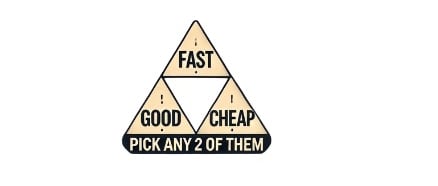Fast Good Cheap... Pick any 2 of them
Understanding Fast, Good, Cheap
5/8/2024


Understanding the "Good-Fast-Cheap" Rule: The Project Management Triangle
When managing a project, one of the most commonly referenced frameworks is the "Good-Fast-Cheap" rule. This rule highlights the trade-offs that are often necessary when deciding how to approach a project or service. It's also referred to as the "Project Management Triangle," where the three points represent quality (good), speed (fast), and cost (cheap).
The rule states:
You can only choose two of the three options.
1. Good and Fast, but not Cheap
If you prioritize quality and speed, you’ll likely need to invest more resources. High-quality materials, skilled labor, and expedited timelines come at a price. Think of a high-end custom software project delivered in weeks instead of months.
2. Fast and Cheap, but not Good
When speed and cost are your top priorities, quality is often compromised. This is common in rushed or budget-constrained projects where the result is functional but might require additional fixes or refinements later.
3. Good and Cheap, but not Fast
When focusing on quality while keeping costs low, the timeline will need to stretch. This allows for efficient use of affordable resources and ample time to maintain standards.
### Why It Matters
The Good-Fast-Cheap rule underscores the importance of setting realistic expectations with stakeholders. Understanding these trade-offs helps project managers make informed decisions that align with the project's priorities.
When planning your next project, ask yourself:
- What is non-negotiable?
- Where is there room to compromise?
The balance you strike will shape the project's outcome—and its success.